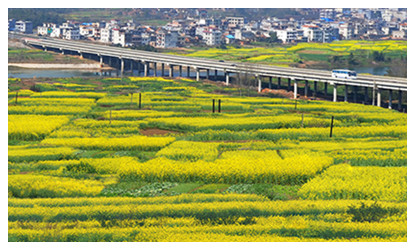Skype: neodalle-travel
Tel: +86 135 7447 2266
E-mail: sales@visitaroundchina.com
By Air
Hunan has completed takeoffs and landings of 205,000 flights in 2020, with a passenger throughput of 23.569 million and a cargo and mail throughput of 195,000 tons. The figures were higher than the six central provinces’ average.
There are 9 airports in Hunan Province. Read More: Changsha Huanghua Airport; Zhangjiajie Hehua Airport, Changde Taohuayuan Airport,Yueyang Sanhe Airport, Hengyang Nanyue Airport,Shaoyang Wugang Airport; Huaihua Zhijiang Airport, Yongzhou Airport, XIangxi Airport; Chenzhou Airport
By Railway
Hunan has a developed railway system. Seven main railway lines – Jingguang (Beijing-Guangzhou), Hukun (Shanghai-Kunming), Xiangqian (Zhuzhou-Guiyang), Zhegan (Hangzhou-Zhuzhou), Xianggui (Hunan-Guangxi), Shichang (Shimenxian-Changsha), and Jiaoliu (Jiaozuo-Liuzhou) railways, pass through the province.
During the 13th Five-year Plan period, Hunan has built 991 km of new railway. The total mileage of operational railway reached 5,582 km, among which the mileage of high-speed railway was 1,986 km, ranking third nationwide. Twelve cities and prefecture can be reached through railway.
The north-south Beijing-Guangzhou High-speed Railway, a key part of Chinese "eight vertical and eight horizontal" high-speed railway network, and the world's longest high-speed rail, runs through Hunan. Its Wuhan-Guangzhou section (Wuguang High-speed Railway) opened to traffic in December 2009. It shortened the journey from Changsha to Wuhan to one hour, to Guangzhou two hours, and to Beijing five hours.
Hukun (Shanghai to Kunming) High-speed Railway went into operation on December, 2014. It reduced travel time between Changsha and Shanghai to 4 hours and 26 minutes, and that between Changsha and Hangzhou to 3 hours and 38 minutes.
Yuchangxia (Chongqing-Changsha-Xiamen) High-speed Railway, a part of Chinese "Eight Vertical and Eight Horizontal" railway network, has three sections in Hunan – Qianjiang (Chongqing)-Zhangjiajie-Changde, Chengde-Yiyang-Changsha, and Changsha-Ganzhou (Jiangxi Province). The Changsha-Ganjiang section is on preliminaries. The Qianjiang-Zhangjaijie-Changde section started trial operation in November, 2019.
By Highway

The total mileage of expressways in service was 6,802 km, including 1,151 km of newly-built ones, ranking 7th nationwide. All counties, county-level cities, and rural districts can be reached through expressways within 2020.
There are 19 railway and 25 expressway accesses to adjacent provinces. All expressway toll booths at provincial borders were cancelled. A two-hour province-wide high-speed railway transport circle has been developed, and Beijing, Shanghai, Shenzhen, and Guangzhou can be reached within 5, 4, 3, and 2 hours. A four-hour expressway transport circle was formed.
The Shimen-Cili Section of Anxiang-Cili Expressway was completed and opened for trial operation on December 30, 2020, making highway service access to all Hunan counties. Since then, all of the Hunan’s 122 counties and cities can connect with expressways in half an hour.
By Ship
Hunan is a water province, centered on the Dongting Lake and including the Xiangjiang, Zijiang, Yuanjiang and Lishui trunk rivers. A complex water network links up the whole province.Total inland waterway mileage hit 12,000 km, ranking third nationwide. The thousand-ton-and-above waterways reached 1,139 km, with 112 thousand-ton-and-above berths.
The Chenglingji Port in Yueyang is the only deepwater harbor connecting the rivers and the seas along Yangtze River in Hunan Province. The seagoing vessels with a capacity of 10,000 tons can go directly to the port. Up to 2025, the port’s designed annual container throughput will reach 800,000 FEUs, making it a competitive leading port along the middle and upper reaches of the Yangtze River over Chongqing and Wuhan.It also has direct routes to Hong Kong and Macao, and can transfer to maritime transport to ASEAN countries and Australia.
Chenglingji Port of Yueyang has been officially included in the first batch of designated ports for imported grain in China, and was the first authorized finished vehicles import port in central China, with its first batch of vehicles being approved for licensing on March 1st, 2016.
Changsha New Port has seven regional branch routes for international containers, and has initiated over 10 international routes to Korea, Japan, West of America, Europe, Australia, Africa, Eest of South America, and Mediterranean. The port has over 40 liners for import and export of international containers. As they enter the Xiangjiang River, freights are shipped to base ports all over the world via Shanghai port in Yangtze River. In this manner, an advantageous waterway network system, spreading globally and reaching various rivers and oceans, is established covering over 60% of load/ unload of containers in regional branch routes of Changsha and central Hunan. Within the single July of 2013, the container throughput of the port reaches 9,725, a year-on-year growth of 20%. Currently, the third phase of construction is under progress in Changsha New Port, whose annual throughput is expected to reach 10 million tons after the implementation.
 Ask Questions ?
Ask Questions ?